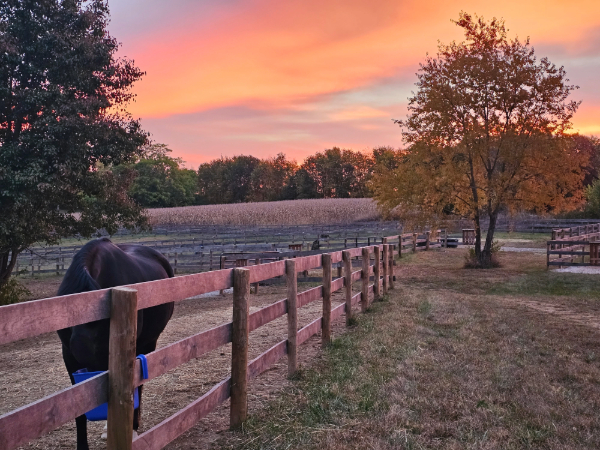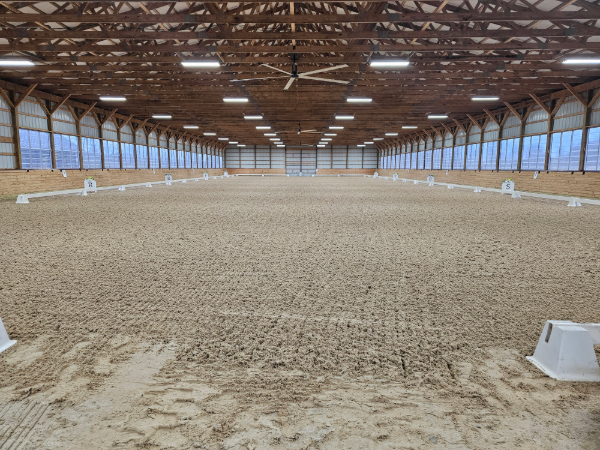Katherine Short is a meticulous stable owner when it comes to anything that affects the health and well-being of horses who live at her Copper Beech Farm in Georgetown, KY. Keeping horses at other people’s properties over the years taught her a lot about what she did and didn’t want when it came time to build her own stable. That’s largely why air quality rules at her Copper Beach.

Her life as a horse owner and career as a claims handler for AXA-XL Insurance gave Katherine a keen understanding of the many ways horses can hurt themselves or become unhealthy.
All of that informed her priorities for designing Copper Beech and planning for its safe and efficient management, daily and over time.
Katherine started from scratch with air quality and air flow as clear priorities. “I wanted big wide aisles, and big open windows and doors because air quality is very important to me.”
Designing for good air quality is most veterinarians’ top tip for barn builders or remodelers. That’s because exposure to respirable particles is the #1 cause of non-infectious respiratory problems that affect over 80% of active sport horses.
Respiratory Realities

Even occasional coughs can be indicators that a horse is struggling with inflammation and excess mucus that restrict the intake of oxygen and the exhalation of carbon dioxide. Bad air quality is indicated by dust particles that settle and irritate the lining of the respiratory tract and lungs.
Katherine knew that bedding for Copper Beech’s 14 stalls would heavily impact air quality. She considered the quantities of dust in traditional wood shavings and other options — on arrival, when they’re stirred up by movement and as they break down with use.
Bedding consideration is especially important because horses spend much of their stall time with their noses hovering over the bedding – either while eating or lying down to rest or sleep. A horse’s nostrils are the gateway to their respiratory system.
Katherine identified Airlite bedding as an ideal fit for her air quality priorities. Made of dust-extruded, pre-consumer cardboard, Airlite’s initial appeal was its dust-free quality. “You open the bag and dump it out and there’s just no dust,” she reports. That’s the case even when the durable bedding has been in use for extended periods thanks to Airlite’s unique structural integrity — it doesn’t break down to dust.
Proof In The Rafters
At Copper Beech, the proof is in the rafters after using Airlite exclusively since it opened 18 months ago. Proudly pointing to the stable’s high ceiling and their clean beams, Katherine says, “One thing I see a lot in barns is cobwebs full of grey, yucky dust. I didn’t want that!”
Hunter/jumper trainer Amanda Birriel bases her Wildflower Sporthorses at Copper Beech. The emphasis on air quality was a major selling point for the young professional.
“We spend a lot of time building up sporthorses and riders and environment is key to that,” she explains. “It’s the first thing we focus on. Something as simple as bedding is really important to creating happy healthy horses.”
Amanda loves entering the barn every day and smelling hay rather than the ammonia odors that many people accept as a normal part of life with horses.
Ammonia odors result from urea in urine and Airlite is unique in its ability to neutralize this compound. These off-gases irritate the human and equine respiratory tract. Plus, their harmful impact increases with duration of exposure. If ammonia odors are noticeable, they’re already at harmful levels. And their absence is a great indicator of healthy air quality.
Amanda sees Airlite’s benefits in several ways. “Especially for horses that have had tie-back surgery and those performing at a high level, we notice the change in how they recover from work. It’s incredible. And our horses are all happy here. They lie down a lot and are happy and comfortable on the bedding.”
Horsemanship Hub

Although it’s relatively new on the scene, Copper Beech is already a hub for horsemanship education. Amanda emphasizes horse health and care with all her clients – from beginner kids to competitive adults. Sharing and demonstrating healthy horse keeping and management strategies is a big part of that.
A 200 x 80’ indoor arena with GGT footing enables year-round riding and clinics with top hunter/jumper and dressage coaches. Side and end panels can be opened to keep things cool on hot summer days and closed in the winter to keep things cozy. Greenheck industrial ceiling fans keep the air moving through the arena year-round.
Renowned Irish show jumping coach Fleur Bryan is a favorite regular clinician. Ride-A-test days and schooling opportunities are also on the Copper Beech agenda throughout the year.
Katherine enjoys hosting American Connemara Pony Society Region V events, a reflection of her lifelong love for the breed. In fact, Katherine’s introduction to the Lexington area was in 2010, when she came to organize a Connemara demonstration during the World Equestrian Games.
In leading by example, Copper Beech and Wildflower Sporthorses keep their horses happy and healthy, while growing a community that acts for the health of their horses, their clients and our planet.





